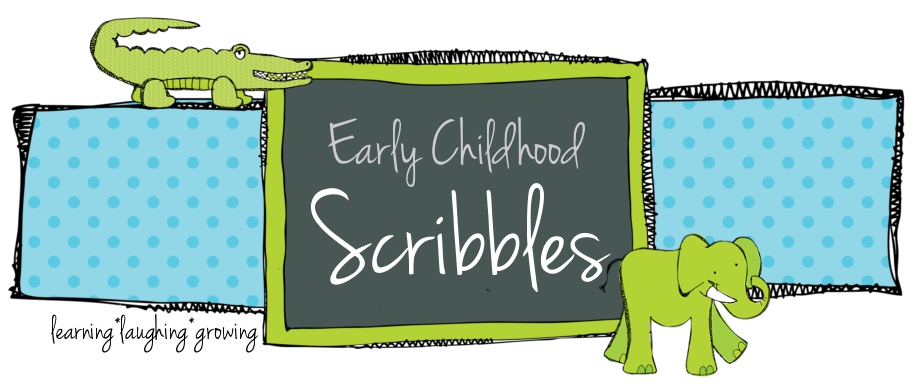THE biggest time consumer as a preschool teacher is portfolios! I love creating student portfolios. (I'm a scrapbooker/photo book designer, so I'm all about the nostalgia!) Therefore, I pour WAY too much time into these things! But, even if you go for the bare minimum, they still take a lot of time. I go for a mix between nostalgia/memories and showing student growth throughout the year. So I've created a packet for the literacy portion of the portfolio. Hopefully this will save you (and ME!) some time.
You can download the packet here. If you're not into the whole TPT thing, don't runaway yet! There are still lots of great ideas ahead!
I've modified some of the pages I've done in the past, to make it useful universally. :) Check it out below.
Portfolio Section Divider
Divider pages add organization to your portfolio and let the reader (usually parents) know what to look for and why it is significant. *Tip* Add color and pizazz to your portfolio's by printing some pages (such as dividers) on colored paper.
Pictures
Like I said, I'm all about the nostalgia! Pictures are a great way to personalize the portfolio and get away from worksheets. We use project construct at our school, and try to stay away from worksheets. This allows us to document how students are learning through play. You can see the student above reading our large group poster using a pointer. She's moving the pointer from left to right. This isn't something that's easily documented in a "worksheet". *Tip* Check out online websites such as snapfish and winkflash for cheap or even free pictures! (Also, we always asked for walgreens gift cards on our donation board)
Document Fun Learning Activities
Again with the nostalgia! I'm all about avoiding worksheets. This is another great way to show parents (and administrators!) how children are learning through fun (*gasp) and play! On this artifact students practice writing their name, practice rhyming and writing letters, and tell about their favorite Dr. Seuss books. *Tip* I have each student choose their favorite book from the library, then copy the title from the book onto the page. This is a great introduction to the "word walls" they'll use in Kindergarten.
Writing Prompts/Literacy Extensions
Whatever you choose to call them, they're great! This is a great way to practice a small amount of writing, and increase comprehension of a story. I've included 3 different literacy extensions, so you're bound to have at least one of the books in your classroom library. *Tip #1* Read the book multiple times throughout the week/month before doing an extension activity. This increases comprehension and more of your students will benefit from the activity. *Tip #2* These make great class books! I always use a folder (with brads) and put the students' pages together with page protectors. We read them together as a class and store them in the classroom library. When we're done with the book, I move the pages to each child's portfolio.
Retelling
I intentionally made this page generic, so you can use it with any story. The Very Hungry Caterpillar by Eric Carle and any version of The Three Little Pigs are my go to favorites for retelling. It is very important to reread MANY times in order for students to be able to retell. *Caution* I use retelling as a way to get a big picture of language skills, sense of story, and comprehension. It's important to remember what is appropriate retelling for early childhood. This tool is best when used to record retelling skills over a period of time,(Beginning, middle, and end of year) and comparing to see student growth. *Tip* Individualize questions during large group reading time based on what you learn from this assessment.
Language Skills
I always use the "I Can Answer Questions" in the fall and the "Show-n-Share" in the spring. This adds variety to the portfolio but still shows growth in language. *Tip* Print the rubric on the back of the artifacts and make a copy to send home. This allows parents to know what type of questions they should focus on when conversing with their children.
Writing
The boring worksheet! :( But this assessment is very useful, because it's an easy way for me to see what letter formation each child still needs extra practice with. *Tip* When not assessing, write letters with a paintbrush in sand, make foam letter roads for cars to drive on, use white boards, and any other ideas you can find on pinterest, to get away from the worksheets and allow the students to learn through play.
I transition to this journal page towards the end of the year for my kindergarten bound kiddos. They're ready for the boundaries of boxes and lines in their journals. The rest of the year we use plain, boundary free white paper for students to write and draw as they wish.
We use this activity at the beginning of the year, when we learn about names. Use the first letter of the students name to make their bells ring. This is a great way for students to learn each others name and begin sound play. (Maleah's bells go ming, mong, ming. Kate's bells go king, kong, king.) I alternate between "Are You Sleeping?" and "The Wheels on the Bus" since I have some of my students for two years.
Letter Recognition
We always use our animated literacy curriculum for this activity, but since it's copyrighted, I used a public domain nursery rhyme to include in the packet.
I have many more ideas for science, math, social emotional, & physical health/safety. I hope to get packets completed and uploaded for those sections soon.
Hopefully saving you time!

























